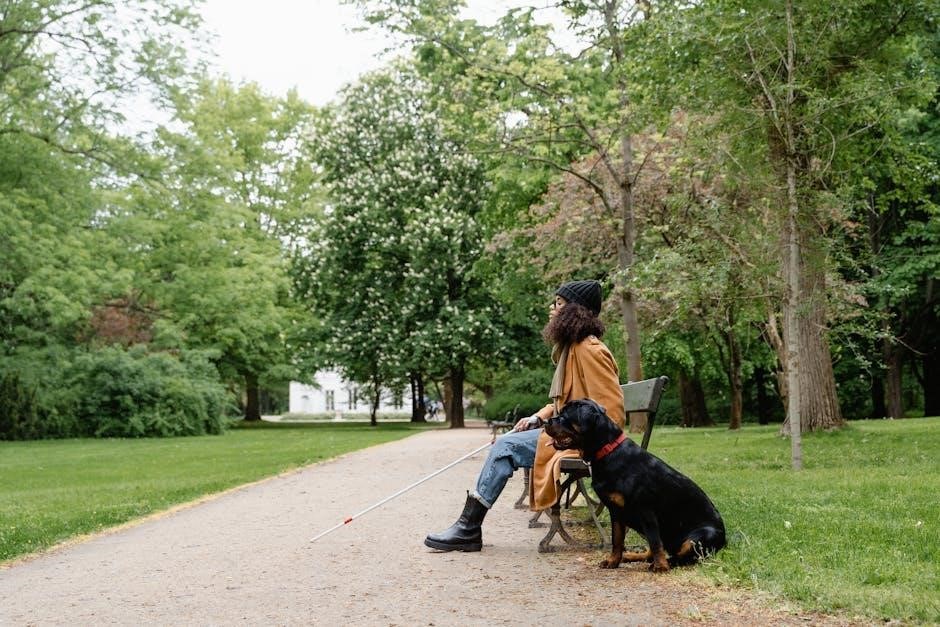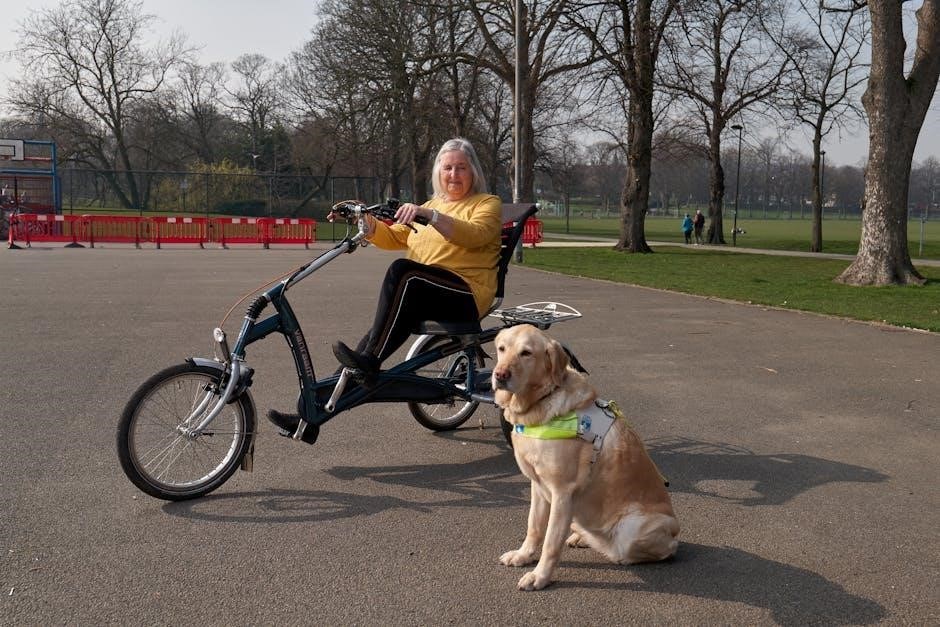
cystotomy dog guide
Cystotomy in dogs is a surgical procedure involving an incision into the bladder to address urinary issues like stones, infections, or obstructions. It is a common intervention in veterinary medicine, providing relief and improving urinary function. The procedure is typically recommended when non-surgical options fail to resolve the underlying condition. Cystotomy allows veterinarians to directly treat bladder abnormalities, ensuring better long-term health outcomes for dogs. Proper preoperative care, precise surgical techniques, and thorough postoperative management are essential for a successful recovery.
1.1 Definition and Purpose of Cystotomy
Cystotomy is a surgical procedure where an incision is made into a dog’s bladder to access its interior. It is primarily performed to diagnose or treat conditions such as bladder stones, infections, or obstructions. The purpose of cystotomy is to remove abnormalities, restore normal urinary flow, and prevent complications. This intervention is essential when non-invasive methods fail to resolve the issue, ensuring the dog’s urinary health and overall well-being. It is a precise and effective treatment option in veterinary medicine.
1.2 Overview of the Procedure
Cystotomy involves making a surgical incision into the dog’s bladder to access its interior. The procedure is typically performed under general anesthesia to ensure the dog remains still and pain-free. Veterinarians use specialized tools to remove stones, tumors, or other abnormalities. The bladder is then closed with sutures, and the dog is closely monitored during recovery. The goal of cystotomy is to restore normal urinary function, alleviate symptoms, and prevent future complications, ensuring the dog’s overall health and comfort.
Medical Indications for Cystotomy in Dogs
Cystotomy is performed to treat bladder stones, obstructions, infections, ectopic ureters, and tumors, improving urinary function and enhancing the dog’s quality of life.
2.1 Bladder Stones (Cystic Calculi)
Bladder stones, or cystic calculi, are hard mineral formations that develop in the urinary bladder. They can cause obstruction, pain, and recurrent infections. Cystotomy is often necessary to remove these stones, restoring normal urination. After removal, the stones are analyzed to determine their composition, helping veterinarians recommend dietary changes to prevent recurrence. This procedure is critical for relieving discomfort and ensuring proper urinary function in affected dogs.
2.2 Urinary Tract Obstruction
Urinary tract obstruction is a life-threatening condition where blockages, such as stones or tumors, prevent normal urine flow. Cystotomy is often required to relieve the obstruction, ensuring proper drainage and preventing complications like kidney damage or sepsis. By surgically removing the blockage, veterinarians restore normal urinary function, alleviating pain and improving the dog’s quality of life. Prompt intervention is critical to avoid severe health risks associated with untreated obstruction.
2.3 Chronic Urinary Tract Infections
Chronic urinary tract infections (UTIs) in dogs often result from underlying bladder issues, such as stones or anatomical abnormalities. Cystotomy is frequently necessary to address these root causes, as standard antibiotic treatments may fail to resolve recurring infections. By surgically removing obstructions or abnormalities, veterinarians can eliminate bacterial breeding grounds, reducing the likelihood of future infections. This procedure is crucial for dogs with persistent UTIs, improving their comfort and long-term urinary health.
2.4 Ectopic Ureters
Ectopic ureters are a congenital condition where the ureters improperly connect to the bladder, leading to urinary incontinence and recurrent infections. Cystotomy is often required to correct this anomaly, allowing surgeons to reposition or implant the ureters properly. This procedure resolves incontinence, reduces infection risk, and improves urinary function. It is a critical intervention for dogs with ectopic ureters, ensuring better long-term health and quality of life by addressing the underlying structural issue.
2.5 Tumors in the Bladder
Bladder tumors in dogs, such as mast cell carcinomas or transitional cell carcinomas, can cause obstructive symptoms and bleeding. Cystotomy is often necessary to remove these growths, providing both diagnostic and therapeutic benefits. The procedure allows for tumor extraction and biopsy, aiding in histopathological identification. While surgery is effective, it may be part of a broader treatment plan, including chemotherapy or radiation, depending on the tumor type and stage. Early intervention is key to improving outcomes and quality of life for affected dogs.
Surgical Procedure for Cystotomy
Cystotomy involves making a surgical incision into the dog’s bladder to remove stones, tumors, or obstructions. The procedure includes thorough irrigation and careful closure to prevent leakage.
3.1 Preoperative Preparation
Preoperative preparation for cystotomy involves a thorough physical examination, blood tests, and imaging to assess the dog’s overall health and confirm the need for surgery. The veterinarian may also perform a urinalysis to check for infections. Fasting is typically required to prevent complications during anesthesia. Additionally, any pre-existing medical conditions, such as kidney disease, are managed to ensure the dog is stable for the procedure. Proper preparation minimizes risks and ensures a smooth surgical experience.
3.2 Surgical Technique and Steps
The surgical procedure begins with general anesthesia to ensure the dog remains still and pain-free. A midline abdominal incision is made to access the bladder. Sterile instruments are used to carefully open the bladder wall, allowing the removal of stones, tumors, or other obstructions. The bladder is then flushed to eliminate remaining debris. After addressing the issue, the bladder and abdominal incisions are closed in layers. The procedure is performed with precision to minimize complications and ensure a smooth recovery.
Postoperative Care and Recovery
Postoperative care involves monitoring for complications, managing pain, restricting activity, and ensuring proper wound healing. Follow-up vet visits are crucial for a successful recovery.
4.1 Immediate Recovery and Monitoring
After cystotomy, dogs are closely monitored in the hospital for several hours to ensure recovery from anesthesia. Vital signs, such as heart rate, breathing, and blood pressure, are checked regularly. Pain management is prioritized, with medications administered to keep your dog comfortable. A urinary catheter may be in place to drain urine and prevent bladder distension. The surgical site is observed for swelling or discharge. Owners should restrict their dog’s activity to prevent complications during the initial healing phase.
4.2 Home Care Instructions
Post-surgery, monitor your dog’s incision site daily for redness or swelling. Provide a quiet, comfortable space to reduce stress. Follow dietary recommendations to prevent bladder stone recurrence. Administer pain medication as prescribed to ensure comfort. Restrict activity to prevent dislodging sutures. Avoid baths until the incision fully heals. Watch for signs of urinary difficulty or infection. Schedule follow-up appointments to monitor healing and remove sutures. Adhere to all veterinary advice to support a smooth recovery.
4.3 Managing Pain and Discomfort
Post-cystotomy, managing your dog’s pain is crucial for recovery. Veterinarians typically prescribe pain relief medications, such as NSAIDs or opioids, to alleviate discomfort. Monitor your dog for signs of pain, including whining, restlessness, or lack of appetite. Ensure medications are administered as directed to prevent complications. Gentle movement and a stress-free environment can also help reduce discomfort. Always follow veterinary advice to ensure your dog’s recovery is as smooth and pain-free as possible.
Risks and Complications of Cystotomy
Cystotomy carries risks such as surgical infections, bladder leakage, and recurrence of bladder stones. Monitoring and proper veterinary care are essential to minimize these complications effectively.
5.1 Surgical Infections
Surgical infections are a potential risk following cystotomy in dogs. These infections can occur at the incision site or within the bladder. Proper sterile techniques during surgery and the use of antibiotics help minimize this risk. Postoperative monitoring is crucial to identify early signs of infection, such as redness, swelling, or discharge. If an infection develops, it may require additional treatment, including antibiotics or, in severe cases, further surgery. Regular follow-ups with the veterinarian are essential to ensure proper healing and prevent complications.
5.2 Leakage from the Bladder
Leakage from the bladder is a possible complication following cystotomy in dogs. This occurs when the surgical site fails to seal properly, allowing urine to leak internally or externally. Symptoms include swelling, pain, or visible urine drainage at the incision site. If leakage is suspected, immediate veterinary attention is crucial. Treatment may involve additional surgery to repair the bladder wall or manage any resulting infection. Monitoring and follow-up care are essential to prevent long-term complications and ensure proper healing.
5.3 Recurrence of Bladder Stones
Recurrence of bladder stones is a potential risk after cystotomy in dogs, especially if underlying causes are not addressed. Factors such as diet, genetics, or metabolic disorders can contribute to new stone formation. Regular monitoring, dietary adjustments, and preventive measures are essential to minimize this risk. Veterinarians often recommend specific diets to reduce mineral concentrations in urine, helping to prevent future stones. Owners should remain vigilant for signs of urinary issues and consult their vet promptly if symptoms recur.

Cost and Insurance Considerations
Cystotomy costs vary based on location, clinic type, and dog size, ranging from $500 to $2,000. Pet insurance may cover part of the procedure if deemed medically necessary, but coverage depends on the policy. Owners should consult their vet and insurance provider to understand financial obligations and potential reimbursement.
6.1 Factors Affecting the Cost of Cystotomy
The cost of cystotomy in dogs varies based on factors like location, clinic type, and dog size. Urban areas and specialty clinics often charge more. Complexity of the procedure, such as the presence of multiple stones or underlying conditions, can increase fees. Preoperative tests, anesthesia, and postoperative care also influence the total cost. Additionally, the surgeon’s experience and the need for advanced equipment may impact pricing. Pet insurance coverage can help, but policies vary in their reimbursement limits and conditions.
6.2 Pet Insurance Coverage for the Procedure
Pet insurance coverage for cystotomy varies by policy and provider. Many plans cover surgical procedures like cystotomy if they are deemed medically necessary. However, pre-existing conditions or related health issues may be excluded. Policies often require a waiting period before covering surgical interventions. It’s essential to review your insurance plan to understand coverage limits, deductibles, and any exclusions. Some plans may cover diagnostic tests and postoperative care, but not all. Always verify the terms before proceeding with the procedure.

Preventing Future Urinary Issues
Preventing future urinary issues involves dietary adjustments, regular veterinary checkups, and ensuring proper hydration. Avoiding certain foods can reduce the risk of bladder stones and infections, improving overall health.
7.1 Dietary Changes to Prevent Bladder Stones
Dietary changes play a crucial role in preventing bladder stones in dogs. Feeding a balanced diet low in protein and certain minerals can reduce stone formation. Increasing moisture intake by adding water to food or feeding wet diets helps dilute urine, minimizing crystal formation. Avoiding fillers and by-products can also support urinary health. Veterinarians may recommend specific diets based on the type of stones previously identified. Regular monitoring and adjustments ensure long-term prevention and overall urinary well-being for dogs.
7.2 Regular Veterinary Checkups
Regular veterinary checkups are essential for maintaining urinary health in dogs, especially after cystotomy. These visits allow early detection of potential issues, such as stone recurrence or infections. Vets perform urinalyses, blood tests, and imaging to monitor bladder health. Adjustments to diet or treatment plans can be made based on these evaluations. Consistent checkups ensure long-term well-being and prevent complications, fostering a speedy recovery and improving quality of life for dogs with urinary conditions.
Diagnosis and Testing
Diagnosis for cystotomy involves urinalysis to detect infections or stones, blood tests to assess kidney function, and imaging techniques like X-rays or ultrasound to visualize bladder issues.
8.1 Urinalysis and Blood Tests
Urinalysis is crucial for detecting bladder stones, infections, or abnormalities in urine composition. It identifies crystals, bacteria, or blood, which may indicate urinary tract issues. Blood tests assess kidney function and overall health, ensuring the dog is fit for surgery. These tests help diagnose underlying conditions like infections or kidney disease, guiding the decision for cystotomy. Accurate results ensure tailored treatment plans, minimizing risks and optimizing surgical outcomes for dogs undergoing the procedure.
8.2 Imaging Techniques (X-rays, Ultrasound)
Imaging techniques like X-rays and ultrasound are essential for diagnosing bladder issues in dogs. X-rays help detect bladder stones or obstructions, while ultrasound provides detailed images of the bladder’s structure. These tools allow veterinarians to visualize abnormalities, such as stones, tumors, or thickened bladder walls. Imaging aids in planning the cystotomy procedure and confirms the need for surgical intervention. Accurate visualization ensures a precise diagnosis, guiding effective treatment and improving surgical outcomes for dogs with urinary tract problems.

Decision-Making for Dog Owners
Deciding on cystotomy involves weighing the severity of your dog’s condition, potential risks, and benefits. Consulting with a veterinarian helps determine if surgery is necessary and ensures informed choices for your dog’s health and well-being.
9.1 When Cystotomy is Necessary
Cystotomy is necessary when non-surgical treatments fail to resolve severe bladder issues like large stones, persistent infections, or life-threatening obstructions. It is often required for conditions causing significant pain or impairing urinary function. Veterinarians recommend cystotomy when less invasive methods cannot address the problem effectively. The procedure becomes critical when the dog’s quality of life is at risk due to recurrent or severe urinary tract problems. Early intervention can prevent complications and improve long-term health outcomes for the dog.
9.2 Alternatives to Surgery
Alternatives to cystotomy include dietary changes, medication, and minimally invasive procedures. For bladder stones, a prescription diet may dissolve or prevent stones. Antibiotics can manage infections, while pain relief helps discomfort. In some cases, laser lithotripsy breaks down stones for easier removal. These options are often preferred for less severe cases or when surgery is risky. However, they may not address all conditions, and surgery remains the most effective solution for severe or persistent issues. Always consult a vet to determine the best approach for your dog.
Recovery and Aftercare Tips
Monitor for complications like infection or leakage, ensure proper wound care, and adhere to medication schedules. Provide a quiet, comfortable space for your dog to recover. Follow dietary advice and restrict activity to prevent strain. Schedule follow-up vet visits to track healing progress and remove sutures if needed. Patience and careful observation are key to a smooth recovery.
10.1 Monitoring for Complications
After cystotomy, closely monitor your dog for signs of complications such as infection, leakage, or swelling at the surgical site. Watch for changes in urination patterns, including difficulty, pain, or blood in the urine. Any unusual behavior, lethargy, or loss of appetite should be reported to your veterinarian promptly. Regular follow-ups ensure early detection and treatment of potential issues, promoting a safer and more effective recovery process for your dog.
10.2 Follow-Up Appointments
Regular follow-up appointments are crucial after cystotomy to ensure proper healing and address any concerns. Your veterinarian will schedule these visits to monitor recovery, remove sutures, and check for signs of infection or complications. Typically, the first follow-up occurs within a week of surgery. These appointments allow your vet to assess the surgical site, review urination habits, and provide guidance on diet or medication. Consistent follow-ups are key to preventing complications and ensuring a smooth recovery for your dog.

Long-Term Outcomes
Successful cystotomy typically results in improved urinary health, resolving symptoms like pain and infections. The procedure enhances a dog’s quality of life, reducing future urinary complications with proper care.
11.1 Recurrence Prevention
Preventing bladder stone recurrence post-cystotomy involves dietary changes, such as feeding specialized diets to reduce mineral concentration in urine. Regular veterinary checkups and urinalyses are crucial for early detection of new stones. Ensuring adequate hydration by encouraging water intake can dilute urine, minimizing crystal formation. Owners should monitor for signs of urinary issues and seek immediate veterinary care if symptoms recur. Consistent follow-up and adherence to vet recommendations significantly lower the risk of future bladder stones.
11.2 Improving Quality of Life
Cystotomy significantly improves a dog’s quality of life by resolving urinary issues that cause pain and discomfort. Post-surgery, dogs often regain normal urinary function, reducing strain and stress. Owners can support their dog’s well-being through proper care, monitoring, and follow-up vet visits. A pain-free bladder and urinary system allow dogs to engage in normal activities, enhancing their overall comfort and happiness. Regular checkups and preventive measures ensure long-term health, contributing to a better quality of life for dogs post-cystotomy.

Owner Experiences and Testimonials
Many dog owners report significant improvement in their pets’ health post-cystotomy, sharing heartfelt stories of relief and renewed vitality. Owners often express gratitude for the procedure.
12.1 Real-Life Stories of Dogs After Cystotomy
Many dog owners share heartfelt stories of their pets’ improved health after cystotomy. One owner reported their Labrador retriever resumed normal activities within weeks, free from prior pain. Another shared how their Poodle regained a happy, energetic life post-surgery. These stories highlight the positive impact of cystotomy, restoring vitality and comfort. Owners often express gratitude for the procedure, emphasizing its life-changing benefits for their beloved pets. These real-life accounts demonstrate the procedure’s effectiveness in improving quality of life for dogs.
Cystotomy in dogs is a life-changing surgical procedure for addressing urinary issues like stones, infections, and obstructions. While it carries risks, proper veterinary care and owner involvement ensure successful recovery. Positive outcomes often restore a dog’s quality of life, allowing them to thrive. Regular checkups and dietary adjustments are key to preventing future problems. Owners should consult their vet to make informed decisions. With careful management, cystotomy can significantly improve a dog’s health and well-being, offering long-term relief from urinary challenges.